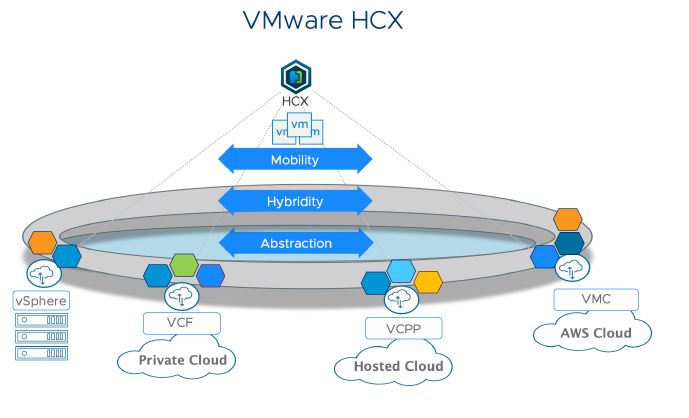VMware Hybrid Cloud Extension (previously known as HCX technologies) was announced by VMware last year during VMworld 2017 Europe, and it aimed at the following use cases:
- Simplified Data Center Migration: Seamless migration of applications from on-premise to cloud.
- Infrastructure Hybridity: Hybrid Cloud Extension enables seamless cloud onboarding.
- Disaster Recovery: In the event of a disaster, Hybrid Cloud Extension recovers the networking layer. Traffic routes are maintained as before the disaster, resulting in high-speed disaster recovery with low downtime.
- Multi-Cloud Application Support: Hybrid Cloud Extension enables application components to exist in the multi-cloud world.
So what exactly is the VMware Hybrid Cloud Extension?
VMware Hybrid Cloud Extension is a SaaS offering that provides application mobility and infrastructure hybridity across different vSphere versions, both on-premises and in the cloud.
To learn more about HCX, please see the VMware HCX FAQ section.
VMware journey from HCM to HCX
Before the HCX solution, VMware offered a similar product named “Hybrid Cloud Manager (HCM)” to support their vCloud Air service. Customers were using HCM to migrate workloads from their on-premises to vCloud Air. Also, it offered features like L2 network stretch, cold migration, and vMotion to the cloud.
Many of you might have seen the Hybrid Cloud Manager icon in Web Client, and when you click on it, it asks you to connect to vCloud Air. But before you could use it, you had to deploy the HCM appliance and register it with your on-premise vCenter server, and then you could connect it to the vCloud Air service.
Last year, VMware sold its vCloud Air service to OVH, and VMware’s focus shifted from Cloud Provider to Cloud Enabler. VMware revised its cloud enabler strategy to support other VMware-based clouds such as IBM Softlayer, OVH Cloud, and lately VMware Cloud on AWS.
With the HCX solution, the main goal of VMware is to deliver a truly seamless infrastructure hybridity service between on-premises and the cloud.
What makes HCX so special?
There are 2 mind-blowing features that HCX offers:
1: vMotion ToCloud: This is also known as live migration. When you initiate a live migration of a VM from on-premise to the cloud, the VM is permanently moved to the cloud when the migration process completes. Now you may be thinking that for vMotion we need the source and destination as ESXi host and if the source host is on-premise and the destination host is in the cloud, how this is happening? The answer for this is via the HCX Cloud Gateway (CGW) virtual machine.
When CGW is deployed, you will see a dummy host appearing in your on-premise and cloud infrastructure and this dummy host is called Mobility Agent (MA). When you initiate vMotion to the cloud, this MA host securely proxy vMotion traffic from the on-premises environment out to the CGW VM which then gets transferred to the cloud and lands on the CGW instance of the cloud and from there to the destination ESXi host.
2: Bulk Migration: Bulk migration helps you to migrate many workloads together to the cloud. Bulk migration uses the native vSphere Replication technology to replicate VMs to the cloud and when initial sync is completed, you can specify a scheduled switch over time, where the deltas are pushed to the VM which got replicated to the cloud and VMs are finally moved to the cloud. Although you have an option to keep a copy of VM in your on-premise.
Hybrid Cloud Extension Components
There are 2 versions of HCX i.e. HCX Enterprise and HCX Cloud. HCX Enterprise is deployed on-premise and HCX cloud is deployed usually on the cloud provider side. Once you deploy HCX Enterprise in your on-premise, you can register it to HCX Cloud using the URL provided by the service provider.
A single HCX-Enterprise instance can handle multiple cloud connections and the same stands true for for HCX-Cloud. Apart from HCX Enterprise and HCX Cloud, we have 3 more components that are part of the HCX deployment:
- Cloud Gateway (CGW)
- WAN Optimizer
- Layer2 Concentrator
These are deployed as virtual machines within the HCX installation (the same as how you deploy an edge gateway within NSX). I am not discussing these components in this post because I want to discuss them separately when we will be deploying them.
I am wrapping up this introduction post here, as I am still trying to learn more and more about this every day. However, you can learn more about HCX from the below links:
I hope you find this post informative. Feel free to share it on social media if it is worth sharing.

